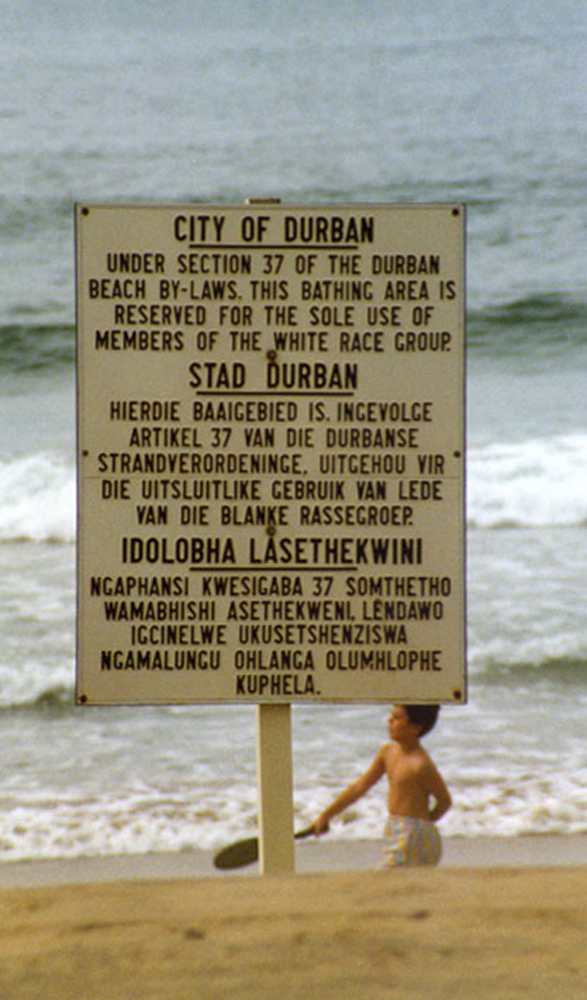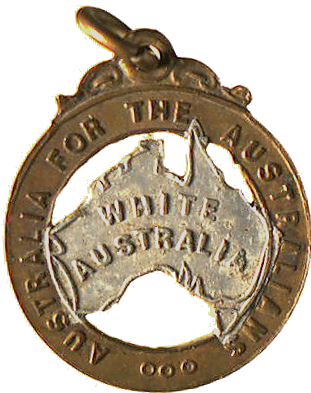Xenophobia
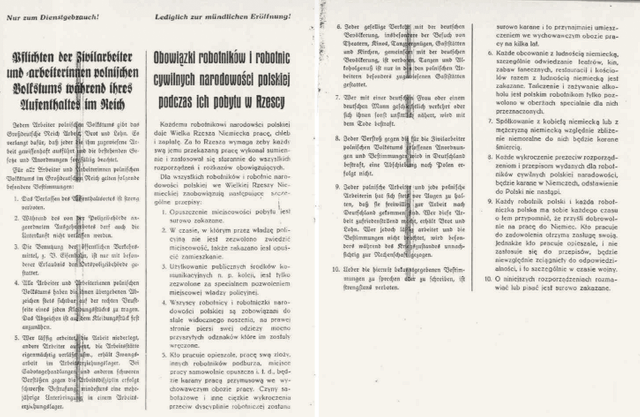
Xenophobia

Xenophobia is the fear or hatred of that which is perceived to be foreign or strange.[1][2][3] Xenophobia can involve perceptions of an ingroup toward an outgroup and can manifest itself in suspicion of the activities of others, and a desire to eliminate their presence to secure a presumed purity and may relate to a fear of losing national, ethnic or racial identity.[4]
Xenophobia can also be exhibited in the form of an "uncritical exaltation of another culture" in which a culture is ascribed "an unreal, stereotyped and exotic quality".[4] According to UNESCO, the terms xenophobia and racism often overlap, but differ in how the latter encompasses prejudice based on physical characteristics while the former is generally centered on behavior based on the notion of a specified people being adverse to the culture or nation.[5]
Definitions
A theorised but political definition of xenophobia, put forward by Andreas Wimmer, is "an element of a political struggle about who has the right to be cared for by the state and society: a fight for the collective goods of the modern state." In other words, xenophobia arises when people feel that their rights to benefit from the government is being subverted by other people's rights.[8]
History
An early example of xenophobic sentiment in Western culture is the Ancient Greek denigration of foreigners as "barbarians", the belief that the Greek people and culture were superior to all others, and the subsequent conclusion that barbarians were naturally meant to be enslaved.[9][10] Ancient Romans also held notions of superiority over all other peoples, such as in a speech attributed to Manius Acilius, "There, as you know, there were Macedonians and Thracians and Illyrians, all most warlike nations, here Syrians and Asiatic Greeks, the most worthless peoples among mankind and born for slavery."[11]
Manifestations
Americas
Brazil
Despite the majority of the country's population being of mixed (Pardo), African, or indigenous heritage, depictions of non-European Brazilians on the programming of most national television networks is scarce and typically relegated for musicians/their shows. In the case of telenovelas, Brazilians of darker skin tone are typically depicted as housekeepers or in positions of lower socioeconomic standing.[12]
Canada
Muslim and Sikh Canadians have faced racism and discrimination in recent years, especially since 2001 and the spillover effect of the United States’ War on Terror.[13] A 2016 survey from The Environics Institute, which was a follow-up to a study conducted 10 years prior, found that there may be discriminating attitudes that may be a residual of the effects of the September 11, 2001 attacks in the United States.[14]
Colombia
According to the UNHCR, by June 2019, there were some 4 million Venezuelan refugees, among whom 1.3 million were in Colombia.[16] Because of their urgent situation, many migrants from Venezuela crossed the border without documentation, indicating they had few opportunities to gain "access to legal and other rights or basic services and are exposed to exploitation, abuse, manipulation and a wide range of other protection risks, including racism, discrimination and xenophobia".[17] Since the start of the migrant crisis, media outlets and state officials warned about the increasing discrimination of migrants in the country, especially xenophobia and violence against the migrants.[18]
Guyana
Mexico
Racism in Mexico has a long history.[22] Historically, Mexicans with light skin tones had absolute control over dark skinned Amerindians due to the structure of the Spanish colonial caste system. When a Mexican of a darker-skinned tone marries one of a lighter skinned-tone, it is common for them say that they are " 'making the race better' (mejorando la raza)." This can be interpreted as a self-attack on their ethnicity.[23] Despite improving economic and social conditions of Indigenous Mexicans, discrimination against Indigenous Mexicans continues to this day and there are few laws to protect Indigenous Mexicans from discrimination. Violent attacks against indigenous Mexicans are moderately common and many times go unpunished.[24]
Venezuela
In Venezuela, like other South American countries, economic inequality often breaks along ethnic and racial lines.[25] A 2013 Swedish academic study stated that Venezuela was the most racist country in the Americas,[25] followed by the Dominican Republic.[25]
United States

Rosa Parks being fingerprinted by Deputy Sheriff D.H. Lackey after being arrested for not giving up her seat on the bus to a white person

U.S. President Donald Trump signing the original travel ban (Executive Order 13769)
Concern over Japanese ethnic and immigrant groups during the Second World War prompted the Canadian and U.S. governments to intern most of their ethnically Japanese populations in the western portions of North America. As in most countries, many people in the U.S. continue to be xenophobic against other races. In the view of a network of scores of US civil rights and human rights organizations, "Discrimination permeates all aspects of life in the United States, and extends to all communities of color." Discrimination against racial, ethnic, and religious minorities, especially when it comes to African Americans, is widely acknowledged. Members of every major American ethnic and religious minority have perceived discrimination in their dealings with other minority racial and religious groups. Philosopher Cornel West has stated that "racism is an integral element within the very fabric of American culture and society. It is embedded in the country's first collective definition, enunciated in its subsequent laws, and imbued in its dominant way of life."[26]
In 2011, additional background checks were imposed on the nationals of Iraq.[27] Foreigners who were nationals of those countries, or who had visited those countries since 2011, were required to obtain a visa to enter the United States, even if they were nationals or dual nationals of the 38 countries participating in the Visa Waiver Program.[28] A few months after the original travel ban a revised ban was signed and Iraq was removed from the list of countries in part due to criticism that the original order overlooked the country's role in fighting Islamic terrorism and barred entry even to the Iraqi interpreters who had been embedded with US forces in the region.[29]
In May 2017, the former Director of National Intelligence James Clapper was criticized for a xenophobic remark in an interview with Chuck Todd from Meet the Press.[30] He told NBC's Meet the Press that Russians are "almost genetically driven" to act deviously.[31][32] Clapper also said that it was in Russian "genes to be opposed, diametrically opposed, to the United States and western democracies."[33]
After Donald Trump took presidential office in 2017, he repeatedly attempted to enact a travel ban on originally seven countries (Iraq, Iran, Somalia, Sudan, Yemen, Syria and Libya) which were listed as "countries of concern" by Secretary of Homeland Security Jeh Johnson under the Obama administration in 2011.[34][35] This was later changed to six in a revision that removed Iraq in part due to criticism that the original order overlooked the country's role in fighting Islamic terrorism and barred entry even to the Iraqi interpreters who had been embedded with US forces in the region.[29][36] Khizr Khan, the father of United States Army Captain Humayun Khan, described it in a CNN interview as a continuation of what he called "Trump's xenophobic rhetoric"[37] and the order was described as xenophobic by Amnesty International.[38] The policy was also criticized for targeting exclusively Muslim majority countries.[29]
In defense of this order, Trump's first press secretary Sean Spicer cited these existing restrictions as evidence that the executive order was based on outstanding policies saying that the seven targeted countries were said to be "countries of particular concern" by the Obama administration.[39] President Trump stated his policy was "similar" to an order in 2011 signed by Barack Obama that "banned visa for refugees from Iraq", where the number of refugees from Iraq dropped from 18,000 to 9,000 as a result of the suspension.[39][40] Though others saw the connection between these two policies as tenuous at best.[41][42]
Asia
Bhutan
In 1991–92, Bhutan is said to have deported between 10,000 and 100,000 ethnic Nepalis (Lhotshampa). The actual number of refugees that were initially deported is debated by both sides. In March 2008, this population began a multiyear resettlement to third countries including the U.S., Canada, New Zealand, Norway, Denmark, the Netherlands and Australia.[43] At present, the United States is working towards resettling more than 60,000 of these refugees in the US as third country settlement programme.[44]
Brunei
Brunei law provides positive discrimination in favor of ethnic Malay.[45]
Indonesia
A number of discriminatory laws against Chinese Indonesians were enacted by the government of Indonesia. In 1959, President Sukarno approved PP 10/1959 that forced Chinese Indonesians to close their businesses in rural areas and relocate into urban areas. Moreover, political pressures in the 1970s and 1980s restricted the role of the Chinese Indonesian in politics, academics, and the military. As a result, they were thereafter constrained professionally to becoming entrepreneurs and professional managers in trade, manufacturing, and banking. In 1998, Indonesia riots over higher food prices and rumors of hoarding by merchants and shopkeepers often degenerated into anti-Chinese attacks.[46]
Malaysia
In 2014, the state of Penang held a referendum that bans foreigners from cooking local cuisines. A well-known local chef, Chef Wan, criticized this law.[47]
Japan
In 2005, a United Nations report expressed concerns about racism in Japan and that government recognition of the depth of the problem was not total.[48][49] The author of the report, Doudou Diène (Special Rapporteur of the UN Commission on Human Rights), concluded after a nine-day investigation that racial discrimination and xenophobia in Japan primarily affects three groups: national minorities, Latin Americans of Japanese descent, mainly Japanese Brazilians, and foreigners(mainly whites) from poor countries.[50]
Japan accepted just 16 refugees in 1999, while the United States took in 85,010 for resettlement, according to the UNHCR. New Zealand, which is 30 times smaller than Japan, accepted 1,140 refugees in 1999. Just 305 persons were recognized as refugees by Japan from 1981, when Japan ratified the U.N. Convention Relating to the Status of Refugees, to 2002.[51][52] Former Prime Minister Taro Aso called Japan a "one race" nation.[53]
South Korea
Xenophobia in South Korea has been recognized by scholars and the United Nations as a widespread social problem.[54] An increase in immigration to South Korea since the 2000s catalyzed more overt expressions of racism, as well as criticism of those expressions.[54][55] Newspapers have frequently reported on and criticized discrimination against immigrants, in forms such as being paid lower than the minimum wage, having their wages withheld, unsafe work conditions, physical abuse, or general denigration.[54]
In a 2010–2014 World Values Survey, 44.2% of South Koreans reported they would not want a foreigner as a neighbor.[55][56] Racist attitudes are more commonly expressed towards immigrants from other Asian countries and Africa, and less so towards European and white North American immigrants who can occasionally receive what has been described as "overly kind treatment".[54][57] Related discrimination have also been reported with regards to mixed-race children, Chinese Korean, and North Korean immigrants.[57]
Thailand
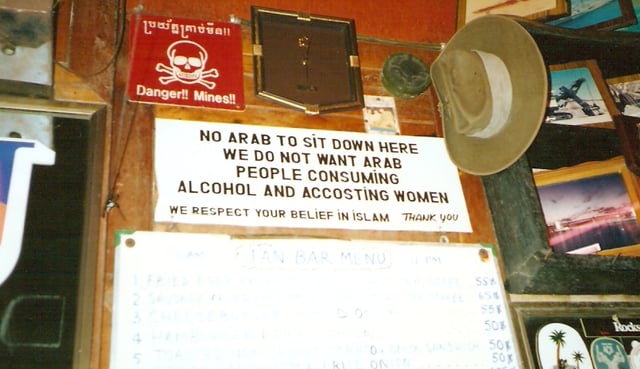
Anti-Arab sign in Pattaya Beach, Thailand
As in much of Asia, dark skin is equated with outdoor labor conditions and the lower classes, but, contrary to the view in Western countries, it is not connected to slavery.[58][59] Thai culture shares this type of skin-toned bias as the rest of Asia. (There are no laws within the Kingdom of Thailand which outlaws racial discrimination inclusive of racist cliches known in the Western world. Unlike its neighboring nations which have been under colonialism, Thailand's heritage as an uncolonized state also shaped its existing laws unlike its Westernized counterparts after decolonization. This also includes signage promoting racial segregation as done in the United States prior to 1964 and South Africa under Apartheid.)
Although Thailand has incorporated certain Western ideals concerning beauty, Asian attitudes regarding skin tones have been around for a long time. The 20 million Isan population for instance, many of whom are of Laotian and Khmer descent, traditionally had darker skin and studies show that many view themselves as less desirable than those with lighter skin. Skin whitening products have proven increasingly popular in most of Asia, including Thailand and are marketed in such a way as to promote light skin as beautiful and desirable.[60]
Middle East
In 2008 a Pew Research Center survey found that negative views concerning Jews were most common in the three predominantly Arab nations polled, with 97% of Lebanese having unfavorable opinion of Jews, 95% in Egypt and 96% in Jordan.[61]
Egypt
Egyptian Muslim Brotherhood leader Mohammed Mahdi Akef has denounced what he called "the myth of the Holocaust" in defending Iranian president Mahmoud Ahmadinejad's denial of it.[62] In an article in October 2000 columnist Adel Hammoda alleged in the state-owned Egyptian newspaper al-Ahram that Jews made Matza from the blood of (non-Jewish) children.[63] Mohammed Salmawy, editor of Al-Ahram Hebdo, "defended the use of old European myths like the blood libel" in his newspapers.[64]
Jordan
Jordan does not allow entry to Jews with visible signs of Judaism or even with personal religious items in their possession. The Jordanian ambassador to Israel replied to a complaint by a religious Jew denied entry that security concerns required that travelers entering the Hashemite Kingdom not do so with prayer shawls (Tallit) and phylacteries (Tefillin).[65] Jordanian authorities state that the policy is in order to ensure the Jewish tourists' safety.[66]
In July 2009, six Breslov Hasidim were deported after attempting entry into Jordan in order to visit the tomb of Aaron / Sheikh Harun on Mount Hor, near Petra, because of an alert from the Ministry of Tourism. The group had taken a ferry from Sinai, Egypt because they understood that Jordanian authorities were making it hard for visible Jews to enter from Israel. The Israeli Ministry of Foreign Affairs is aware of the issue.[67]
Israel
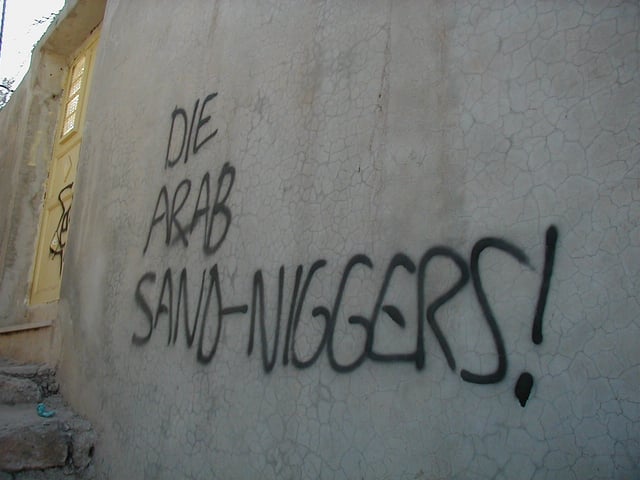
Graffiti reading "Die Arab Sand-Niggers!" reportedly sprayed by settlers on a house in Hebron.[68]
According to the 2004 U.S. State Department Country Reports on Human Rights Practices for Israel and the Occupied Territories, the Israeli government had done "little to reduce institutional, legal, and societal discrimination against the country's Arab citizens."[69] The 2005 US Department of State report on Israel wrote: "[T]he government generally respected the human rights of its citizens; however, there were problems in some areas, including... institutional, legal, and societal discrimination against the country’s Arab citizens."[70] The 2010 U.S. State Department Country Report stated that Israeli law prohibits discrimination on the basis of race, and that government effectively enforced these prohibitions.[71] Former Likud MK and Minister of Defense Moshe Arens has criticized the treatment of minorities in Israel, saying that they did not bear the full obligation of Israeli citizenship, nor were they extended the full privileges of citizenship.[72]
The Association for Civil Rights in Israel (ACRI) published reports documenting racism in Israel, and the 2007 report suggested that anti-Arab racism in the country was increasing. One analysis of the report summarized it thus: "Over two-thirds Israeli teens believe Arabs to be less intelligent, uncultured and violent.[73][74] The Israeli government spokesman responded that the Israeli government was "committed to fighting racism whenever it raises its ugly head and is committed to full equality to all Israeli citizens, irrespective of ethnicity, creed or background, as defined by our declaration of independence".[74] Isi Leibler of the Jerusalem Center for Public affairs argues that Israeli Jews are troubled by "increasingly hostile, even treasonable outbursts by Israeli Arabs against the state" while it is at war with neighboring countries,[75]
Lebanon
Hezbollah's Al-Manar TV channel has often been accused of airing antisemitic broadcasts, blaming the Jews for a Zionist conspiracy against the Arab world, and often airing excerpts from the Protocols of the Elders of Zion,[76][77][78] which the Encyclopædia Britannica describes as a "fraudulent document that served as a pretext and rationale for anti-Semitism in the early 20th century". In another incident, an Al-Manar commentator recently referred to "Zionist attempts to transmit AIDS to Arab countries". Al-Manar officials deny broadcasting antisemitic incitement and state that their position is anti-Israeli, not antisemitic. However, Hezbollah has directed strong rhetoric both against Israel and Jews, and it has cooperated in publishing and distributing outright antisemitic literature. The government of Lebanon has not criticized continued broadcast of antisemitic material on television.[79]
Palestine
Various Palestinian organizations and individuals have been regularly accused of being antisemitic. Howard Gutman believes that much of Muslim hatred of Jews stems from the ongoing Arab–Israeli conflict and that peace would significantly reduce antisemitism.[80]
In August, 2003, senior Hamas official Dr Abd Al-Aziz Al-Rantisi wrote in the Hamas newspaper Al-Risala:
It is no longer a secret that the Zionists were behind the Nazis’ murder of many Jews, and agreed to it, with the aim of intimidating them and forcing them to immigrate to Palestine.[81]
In August 2009, Hamas refused to allow Palestinian children to learn about the Holocaust, which it called "a lie invented by the Zionists" and referred to Holocaust education as a "war crime."[82]
Saudi Arabia
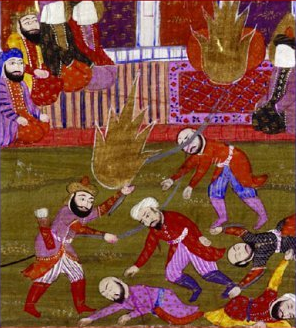
The massacre of the Jewish Banu Qurayza in Arabia
Racism in Saudi Arabia against labor workers who are foreigners, mostly from developing countries. Asians maids have been persecuted victims of racism and discrimination in the country,[83][84][85][86] foreign workers have been raped, exploited, under- or unpaid, physically abused,[87] overworked and locked in their places of employment. The international organisation Human Rights Watch (HRW) describes these conditions as "near-slavery" and attributes them to "deeply rooted gender, religious, and racial discrimination".[88] In many cases the workers are unwilling to report their employers for fear of losing their jobs or further abuse.[88]
There were several cases of antisemitism in Saudi Arabia and is common within religious circles. Saudi Arabian media often attacks Jews in books, news articles, at their Mosques and with what some describe as antisemitic satire. Saudi Arabian government officials and state religious leaders often promote the idea that Jews are conspiring to take over the entire world; as proof of their claims they publish and frequently cite The Protocols of the Elders of Zion as factual.[89][90]
Europe
A study that ran from 2002 to 2015 into social attitudes by Harvard University has mapped the countries in Europe with the highest incidents of racial bias, based on data from 288,076 white Europeans. It used the Implicit-association test (a reaction-based psychological test designed to measure implicit racial bias). The strongest racial bias was found in several Eastern European countries (the Czech Republic, Lithuania, Belarus, Ukraine, Moldova, Bulgaria, Slovakia), as well as Malta, Italy, and Portugal.[91] A 2017 report by the University of Oslo Center for Research on Extremism tentatively suggests that "individuals of Muslim background stand out among perpetrators of antisemitic violence in Western Europe".[92]
Belgium
There were recorded well over a hundred antisemitic attacks in Belgium in 2009. This was a 100% increase from the year before. The perpetrators were usually young males of immigrant background from the Middle East. In 2009, the Belgian city of Antwerp, often referred to as Europe's last shtetl, experienced a surge in antisemitic violence. Bloeme Evers-Emden, an Amsterdam resident and Auschwitz survivor, was quoted in the newspaper Aftenposten in 2010: "The antisemitism now is even worse than before the Holocaust. The antisemitism has become more violent. Now they are threatening to kill us."[93]
France
In 2004, France experienced rising levels of Islamic antisemitism and acts that were publicized around the world.[94][95][96] In 2006, rising levels of antisemitism were recorded in French schools. Reports related to the tensions between the children of North African Muslim immigrants and North African Jewish children.[96] The climax was reached when Ilan Halimi was tortured to death by the so-called "Barbarians gang", led by Youssouf Fofana. In 2007, over 7,000 members of the community petitioned for asylum in the United States, citing antisemitism in France.[97]
In the first half of 2009, an estimated 631 recorded acts of antisemitism took place in France, more than the whole of 2008.[98] Speaking to the World Jewish Congress in December 2009, the French Interior Minister Hortefeux described the acts of antisemitism as "a poison to our republic". He also announced that he would appoint a special coordinator for fighting racism and antisemitism.[99]
Germany
The period after losing World War I led to an increased use of anti-Semitism and other racism in political discourse, for example among the right-wing Freikorps, emotions that finally culminated in the ascent of Adolf Hitler and the Nazi Party in 1933. The Nazi racial policy and the Nuremberg Race Laws against Jews and other non-Aryans represented the most explicit racist policies in Europe in the twentieth century. These laws deprived all Jews including even half-Jews and quarter-Jews as well as other non-Aryans from German citizenship. Jews official title became "subject of the state". The Nuremberg Race Laws forbid racially mixed sexual relations and marriage between Aryans and at first Jews but was later extended to "Gypsies, Negroes or their bastard offspring".[100] Such interracial relations became a criminal and punishable offence under the race laws known as "racial pollution" Rassenschande.[100][101]
Hungary
As in other European countries, the Romani people faced disadvantages, including unequal treatment, discrimination, segregation and harassment. Negative stereotypes are often linked to Romani unemployment and reliance on state benefits.[104] In 2008 and 2009 nine attacks took place against Romani in Hungary, resulting in six deaths and multiple injuries. According to the Hungarian curia (supreme court), these murders were motivated by anti-Romani sentiment and sentenced the perpetrators to life imprisonment.[104]
Italy
Anti-Roma sentiment exists in Italy and takes the form of hostility, prejudice, discrimination or racism directed at Romani people. There's no reliable data for the total number of Roma people living in Italy, but estimates put it between 140,000 and 170,000. Many national and local political leaders engaged in rhetoric during 2007 and 2008 that maintained that the extraordinary rise in crime at the time was mainly a result of uncontrolled immigration of people of Roma origin from recent European Union member state Romania.[105] National and local leaders declared their plans to expel Roma from settlements in and around major cities and to deport illegal immigrants. The mayors of Rome and Milan signed "Security Pacts" in May 2007 that "envisaged the forced eviction of up to 10,000 Romani people."[106]
According to a May 2008 poll 68% of Italians, wanted to see all of the country's approximately 150,000 Gypsies, many of them Italian citizens, expelled.[107] The survey, published as mobs in Naples burned down Gypsy camps that month, revealed that the majority also wanted all Gypsy camps in Italy to be demolished.[107]
Netherlands
In the early 2012 the Dutch right-wing Party for Freedom established an anti-Slavic (predominantly anti-Polish) and anti-Romani website, where native Dutch people could air their frustration about losing their job because of cheaper workers from Poland, Bulgaria, Romania and other non-Germanic Central and Eastern European countries. This led to commentaries involving hate speech and other racial prejudice mainly against Poles and Roma, but also aimed at other Central and Eastern European ethnic groups.[108]
In the Netherlands, antisemitic incidents, from verbal abuse to violence, are reported, allegedly connected with Islamic youth, mostly boys from Moroccan descent. A phrase made popular during football matches against the so-called Jewish football club Ajax has been adopted by Muslim youth and is frequently heard at pro-Palestinian demonstrations: "Hamas, Hamas, Jews to the gas!" According to the Centre for Information and Documentation on Israel, a pro-Israel lobby group in the Netherlands, in 2009, the number of anti-Semitic incidents in Amsterdam, the city that is home to most of the approximately 40,000 Dutch Jews, was said to be doubled compared to 2008.[109]
Norway
In 2010, the Norwegian Broadcasting Corporation after one year of research, revealed that anti-semitism was common among Norwegian Muslims. Teachers at schools with large shares of Muslims revealed that Muslim students often "praise or admire Adolf Hitler for his killing of Jews", that "Jew-hate is legitimate within vast groups of Muslim students," and "Muslims laugh or command [teachers] to stop when trying to educate about the Holocaust." Additionally that "while some students might protest when some express support for terrorism, none object when students express hate of Jews" and that it says in "the Quran that you shall kill Jews, all true Muslims hate Jews." Most of these students were said to be born and raised in Norway. One Jewish father also told that his child after school had been taken by a Muslim mob (though managed to escape), reportedly "to be taken out to the forest and hanged because he was a Jew".[110]
Russia
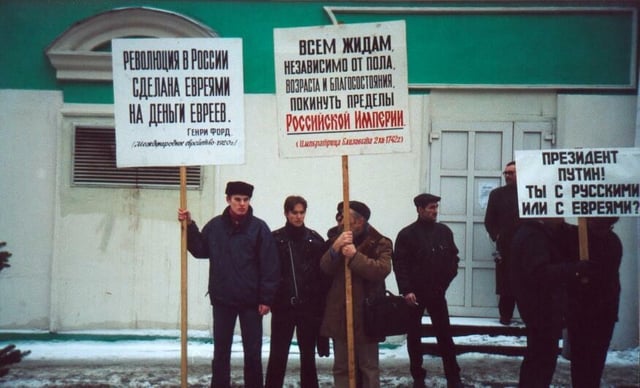
A demonstration in Russia. The antisemitic slogans cite Henry Ford and Empress Elizabeth.
By the beginning of the 20th century, most European Jews lived in the so-called Pale of Settlement, the Western frontier of the Russian Empire consisting generally of the modern-day countries of Poland, Lithuania, Belarus and neighboring regions. Many pogroms accompanied the Revolution of 1917 and the ensuing Russian Civil War, an estimated 70,000 to 250,000 civilian Jews were killed in the atrocities throughout the former Russian Empire; the number of Jewish orphans exceeded 300,000.[111][112]
In the 2000s, neo-Nazi groups inside Russia had risen to include as many as tens of thousands of people.[113] Racism against both the Russian citizens (peoples of the Caucasus, indigenous peoples of Siberia and Russian Far East, etc.) and non-Russian citizens of Africans, Central Asians, East Asians (Vietnamese, Chinese, etc.) and Europeans (Ukrainians, etc.) is a significant problem.[114]
In 2016, Radio Free Europe/Radio Liberty reported that "Researchers who track xenophobia in Russia have recorded an "impressive" decrease in hate crimes as the authorities appear to have stepped up pressure on far-right groups".[115]
Sweden
A government study in 2006 estimated that 5% of the total adult population and 39% of adult Muslims "harbour systematic antisemitic views".[116] The former prime minister Göran Persson described these results as "surprising and terrifying". However, the rabbi of Stockholm's Orthodox Jewish community, Meir Horden, said, "It's not true to say that the Swedes are antisemitic. Some of them are hostile to Israel because they support the weak side, which they perceive the Palestinians to be."[117]
In March 2010, Fredrik Sieradzk told Die Presse, an Austrian Internet publication, that Jews are being "harassed and physically attacked" by "people from the Middle East", although he added that only a small number of Malmö's 40,000 Muslims "exhibit hatred of Jews". Sieradzk also stated that approximately 30 Jewish families have emigrated from Malmö to Israel in the past year, specifically to escape from harassment. Also in March, the Swedish newspaper Skånska Dagbladet reported that attacks on Jews in Malmö totaled 79 in 2009, about twice as many as the previous year, according to police statistics.[118] In December 2010, the Jewish human rights organization Simon Wiesenthal Center issued a travel advisory concerning Sweden, advising Jews to express "extreme caution" when visiting the southern parts of the country due to an increase in verbal and physical harassment of Jewish citizens by Muslims in the city of Malmö.[119]
Ukraine
Israel's Antisemitism Report for 2017 stated that "A striking exception in the trend of decrease in antisemitic incidents in Eastern Europe was Ukraine, where the number of recorded antisemitic attacks was doubled from last year and surpassed the tally for all the incidents reported throughout the entire region combined."[120] Ukrainian state historian, Vladimir Vyatrovich dismissed the Israeli report as anti-Ukrainian propaganda and a researcher of antisemitism from Ukraine, Vyacheslav Likhachev said the Israeli report was flawed and amateurish.[120]
Africa
Ivory Coast
In the past recent years, Ivory Coast has seen a resurgence in ethnic tribal hatred and religious intolerance. In addition to the many victims among the various tribes of the northern and southern regions of the country that have perished in the ongoing conflict, white foreigners residing or visiting Ivory Coast have also been subjected to violent attacks. According to a report by Human Rights Watch, the Ivory Coast government is guilty of fanning ethnic hatred for its own political ends.[121]
In 2004, the Young Patriots of Abidjan, a strongly nationalist organisation, rallied by the state media, plundered possessions of foreign nationals in Abidjan. Calls for violence against whites and non-Ivorians were broadcast on national radio and TV after the Young Patriots seized control of its offices. Rapes, beatings, and murders of persons of European and Lebanese descent followed. Thousands of expatriates and white or ethnic Lebanese Ivorians fled the country. The attacks drew international condemnation.[122][123]
Mauritania
Slavery in Mauritania persists despite its abolition in 1980 and mostly affects the descendants of black Africans abducted into slavery who now live in Mauritania as "black Moors" or haratin and who partially still serve the "white Moors", or bidhan, as slaves. The practice of slavery in Mauritania is most dominant within the traditional upper class of the Moors. For centuries, the haratin lower class, mostly poor black Africans living in rural areas, have been considered natural slaves by these Moors. Social attitudes have changed among most urban Moors, but in rural areas, the ancient divide remains.[124]
Niger
In October 2006, Niger announced that it would deport to Chad the "Diffa Arabs", Arabs living in the Diffa region of eastern Niger.[125] Their population numbered about 150,000.[126] While the government was rounding up Arabs in preparation for the deportation, two girls died, reportedly after fleeing government forces, and three women suffered miscarriages. Niger's government eventually suspended their controversial decision to deport the Arabs.[127][128]
South Africa
Xenophobia in South Africa has been present in both the apartheid and post–apartheid eras. Hostility between the British and Boers exacerbated by the Second Boer War led to rebellion by poor Afrikaners who looted British-owned shops.[129] South Africa also passed numerous acts intended to keep out Indians, such as the Immigrants Regulation Act of 1913, which provided for the exclusion of "undesirables", a group of people that included Indians. This effectively halted Indian immigration. The Township Franchise Ordinance of 1924 was intended to "deprive Indians of municipal franchise."[130]
In 1994 and 1995, gangs of armed youth destroyed the homes of foreign nationals living in Johannesburg, demanding that the police work to repatriate them to their home countries.[131] In 2008, a widely documented spate of xenophobic attacks occurred in Johannesburg.[132][133][134] It is estimated that tens of thousands of migrants were displaced; property, businesses and homes were widely looted.[135] The death toll after the attack stood at 56.[131]
In 2015, another widely documented series of xenophobic attacks occurred in South Africa, mostly against migrant Zimbabweans.[136] This followed remarks by Zulu King Goodwill Zwelithini kaBhekuzulu stating that the migrants should "pack their bags and leave".[131][137] As of 20 April 2015, 7 people had died and more than 2000 foreigners had been displaced.[136]
Following the riots and murders of other Africans from 2008 and 2015, violence again broke out in 2019.[138]
Sudan
In the Sudan, black African captives in the civil war were often enslaved, and female prisoners were often abused sexually,[139] with their Arab captors claiming that Islamic law grants them permission.[140] According to CBS News, slaves have been sold for US$50 a piece.[141] In September 2000, the U.S. State Department alleged that "the Sudanese government's support of slavery and its continued military action which has resulted in numerous deaths are due in part to the victims' religious beliefs."[142] Jok Madut Jok, professor of history at Loyola Marymount University, states that the abduction of women and children of the south is slavery by any definition. The government of Sudan insists that the whole matter is no more than the traditional tribal feuding over resources.[143]
Uganda
Former British colonies in Sub-Saharan Africa have many citizens of South Asian descent. They were brought by the British Empire from British India to do clerical work in imperial service.[144] The most prominent case of anti-Indian racism was the ethnic cleansing of the Indian (called Asian) minority in Uganda by the strongman dictator and human rights violator Idi Amin.[144]
Zimbabwe
Oceania
Australia
The Immigration Restriction Act 1901 (White Australia policy) effectively barred people of non-European descent from immigrating to Australia. There was never any specific policy titled as such, but the term was invented later to encapsulate a collection of policies that were designed to exclude people from Asia (particularly China) and the Pacific Islands (particularly Melanesia) from immigrating to Australia.[152] The Menzies and Holt Governments effectively dismantled the policies between 1949 and 1966 and the Whitlam Government passed laws to ensure that race would be totally disregarded as a component for immigration to Australia in 1973.[153]
The 2005 Cronulla riots were a series of race riots and outbreaks of mob violence in Sydney's southern suburb Cronulla which resulted from strained relations between Anglo-Celtic and (predominantly Muslim) Lebanese Australians. Travel warnings for Australia were issued by some countries but were later removed.[154] On December 2005, a fight broke out between a group of volunteer surf lifesavers and Lebanese youth. These incidents were considered to be a key factor in a racially motivated confrontation the following weekend.[155] Violence spread to other southern suburbs of Sydney, where more assaults occurred, including two stabbings and attacks on ambulances and police officers.[156]
On 30 May 2009, Indian students protested against what they claimed were racist attacks, blocking streets in central Melbourne. Thousands of students gathered outside the Royal Melbourne Hospital where one of the victims was admitted.[157] In light of this event, the Australian Government started a Helpline for Indian students to report such incidents.[158] The United Nations High Commissioner for Human Rights, Navi Pillay, termed these attacks "disturbing" and called for Australia to investigate the matters further.[159]
See also
Afrophobia
Aporophobia
Chauvinism
Ethnocentrism
Environmental racism
European Commission against Racism and Intolerance
List of anti-cultural, anti-national, and anti-ethnic terms
List of phobias
Nativism (politics)
Oikophobia
Opposition to immigration
Stranger danger
Überfremdung
Xenocentrism
Xenophilia
Xenophobia in South Africa
